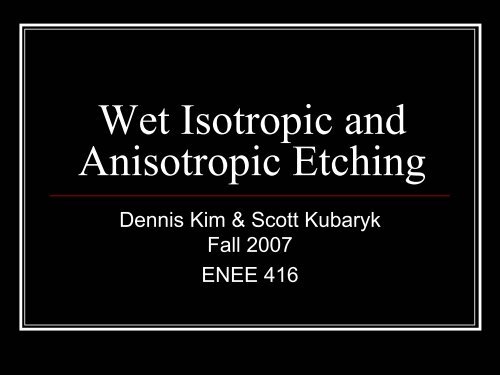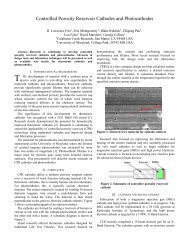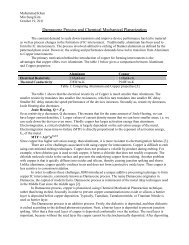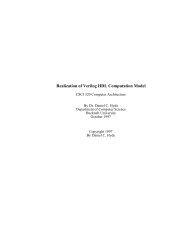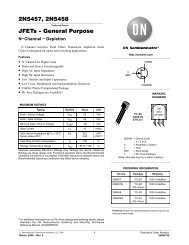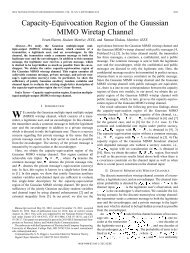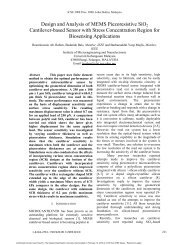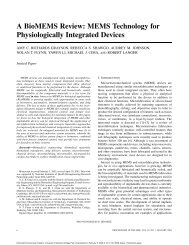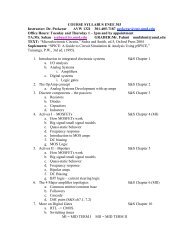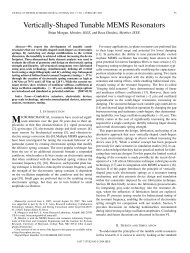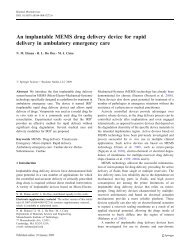Wet Isotropic and Anisotropic Etching - ECE
Wet Isotropic and Anisotropic Etching - ECE
Wet Isotropic and Anisotropic Etching - ECE
You also want an ePaper? Increase the reach of your titles
YUMPU automatically turns print PDFs into web optimized ePapers that Google loves.
<strong>Wet</strong> <strong>Isotropic</strong> <strong>and</strong><br />
<strong>Anisotropic</strong> <strong>Etching</strong><br />
Dennis Kim & Scott Kubaryk<br />
Fall 2007<br />
ENEE 416
Introduction<br />
� <strong>Wet</strong> Silicon <strong>Etching</strong><br />
� <strong>Anisotropic</strong><br />
� <strong>Isotropic</strong>
<strong>Wet</strong> Silicon <strong>Etching</strong><br />
� Process Flow<br />
Transport of<br />
etchant to surface<br />
of wafer Chemical reaction<br />
producing soluble<br />
byproducts<br />
Transport of<br />
products away<br />
from the wafer
<strong>Anisotropic</strong> <strong>Etching</strong><br />
� Orientation Dependent<br />
� Miller indices become very important<br />
� Etch rates differ for different index planes<br />
� KOH etches 54.74° in respect to <br />
http://en.wikipedia.org/wiki/<strong>Etching</strong>_(microfabrication) [3]
<strong>Anisotropic</strong> <strong>Etching</strong> – Etchants<br />
� KOH (Potassium Hydroxide)<br />
� Etch rates of 1-2µm/min [2]<br />
� Low Cost – Widely Available<br />
� Simple equipment (Hotplate <strong>and</strong> Stir)<br />
� Corrosive – Strongly Basic (pH 12-14)<br />
� Not compatible for CMOS fabrication<br />
� Other Alkali Metals May Be Used<br />
� Na (Sodium), Cs (Cesium), Rb (Rubidium)<br />
[7]
<strong>Anisotropic</strong> <strong>Etching</strong> – Etchants<br />
� EDP (Ethylene Diamine Pyrochatechol)<br />
� Etch rates of 0.02 – 1µm/min<br />
� Typically results in Si(OH) 4 deposits [1]<br />
� Higher Equipment Cost<br />
� Corrosive – Carcinogenic – Difficult to Dispose<br />
� Normally not permitted in fab-lab clean rooms<br />
� Not compatible for CMOS fabrication
<strong>Anisotropic</strong> <strong>Etching</strong> – Etchants<br />
� TMAH (Tetra Methyl Ammonium Hydroxide)<br />
� Etch rates of around 1µm/min<br />
� Comparable equipment cost with EDP<br />
� Compatible with CMOS fabrication<br />
� No Alkali metals<br />
[6]
Why <strong>Wet</strong> <strong>Anisotropic</strong> <strong>Etching</strong>?<br />
� Low cost<br />
� Orientation Dependant<br />
� Specific orientations can be etched<br />
� Controllable etch rates<br />
� Smaller <strong>and</strong> more specific etch patterns
Why Not <strong>Wet</strong> <strong>Anisotropic</strong> <strong>Etching</strong>?<br />
� Contamination<br />
� Orientation Dependent<br />
� Must choose wafers carefully<br />
� Etch rates varied by temperature <strong>and</strong><br />
concentration<br />
� Must closely control these variables<br />
� Undercutting still an issue
Etch Rate Dependencies (KOH)<br />
[4]<br />
[5]
<strong>Anisotropic</strong> <strong>Etching</strong> - Applications<br />
� Radiation hardened circuits<br />
� J-FET arrays<br />
� Solar cell anti-reflecting surfaces<br />
� Waveguides<br />
� IR detectors<br />
� High value capacitors
<strong>Isotropic</strong> <strong>Etching</strong> - Etchants<br />
� Hydrofluoric Acid (HF)<br />
� Used with Silicon Dioxide<br />
� Etch rate depends on concentration<br />
� 6:1 (H 2 O to HF) has etch rate of 1200 Å /min<br />
� 10:1, 50:1, <strong>and</strong> 100:1 also used<br />
� Extremely dangerous, hard to detect<br />
� SiO 2 + 6HF � H 2 + SiF 6 + 2H 2 O
<strong>Isotropic</strong> <strong>Etching</strong> - Etchants<br />
� Silicon � Hydrofluoric Nitric Acidic (HNA)<br />
� Silicon Nitride � Phosphoric Acid (H 3 PO 4 )<br />
� Etch rates for pure Si small<br />
� Oxidize Si using nitric acid (HNO 3 )<br />
� Si + HNO 3 + 6HF � H 2 SiF 6 + HNO 2 + H 2 + H 2 O
Iso-Etch Curves<br />
� 3 parts acetic acid<br />
� 3 parts ~70%<br />
HNO 3<br />
� 4 parts ~49% HF<br />
� Etch rate of<br />
solution the curve<br />
corresponding<br />
with intersection<br />
point (56 µm/min)
Undercutting in <strong>Isotropic</strong> <strong>Etching</strong><br />
� A = 1 – R L /R v<br />
� Completely isotropic etch, A = 0 (R L = R v )
Advantages of <strong>Isotropic</strong> <strong>Etching</strong><br />
� Inexpensive<br />
� Simple<br />
� Highly Selective
Disadvantages of <strong>Isotropic</strong> <strong>Etching</strong><br />
� Dangerous<br />
� Pollution<br />
� High likelihood of contamination<br />
� Poor Repeatability<br />
� Temperature<br />
� Concentration
Applications of <strong>Isotropic</strong> <strong>Etching</strong><br />
� When high etch rates needed<br />
� Non-critical tasks<br />
� Large geometries<br />
� Removal of work-damaged surfaces<br />
� Rounding of sharp anisotropically etched<br />
corners<br />
� Structures <strong>and</strong> planes on single-crystal<br />
lattices
References<br />
� [1] http://www.ee.washington.edu/research/microtech/cam/PROCESSES/PDF%20FILES/<strong>Wet</strong><strong>Etching</strong>.pdf<br />
� [2] Gregory T. A. Kovacs, Nadim I. Maluf, <strong>and</strong> Kurt E. Petersen, "Bulk Micromachining of Silicon" Proceedings of<br />
the IEEE, Vol. 86, No. 8, August 1998<br />
� [3] http://en.wikipedia.org/wiki/<strong>Etching</strong>_(microfabrication)<br />
� [4] "BYU Cleanroom - KOH <strong>Etching</strong> of Silicon Wafers, Silicon Dioxide, <strong>and</strong> Silicon Nitride“<br />
http://www.ee.byu.edu/cleanroom/KOH.phtml<br />
� [5] "<strong>Wet</strong> Etch for Microelectronics" Dr. Lynn Fuller http://www.rit.edu/~lffeee/wet_etch.pdf<br />
� [6] http://www.campbellscience.com/product_TMAH.html<br />
� [7] http://en.wikipedia.org/wiki/Potassium_hydroxide


